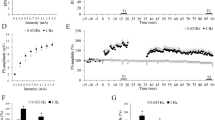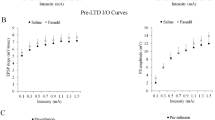Abstract
The molecular mechanisms regulating N-methyl-d-aspartate (NMDA) receptor-dependent synaptic plasticity are complex, and the contribution of Tau protein in the physiological process is not fully understood. Herein, we investigated whether the blockade of NMDA receptor activation might change Tau phosphorylation during long-term potentiation (LTP) and long-term depression (LTD) via contribution of GSK3β as a major Tau kinase. For this, we recorded two components (synaptic and population spike components) of hippocampal field potential, which is evoked by the stimulation of the perforant pathway with high- and low-frequency stimulation (HFS and LFS). We found under a 20-µl volume of D-AP5 infusion lasting 1 h that,HFS caused significant synaptic depression, whereas LFS induced a synaptic potentiation. Both the HFS and LFS protocols resulted in a significant increase in population spike component but were characterized by a slow increase in amplitude that occurred with the LFS. D-AP5 attenuated HFS-induced population spike potentiation, but augmented LFS-induced population spike potentiation. The enzymatic activity of GSK-3β was decreased by D-AP5 infusion in the hippocampus, indicating that NMDA receptor activity modulates the enzymatic activity of GSK-3β. In addition, NMDA receptor blockade reduced tau expression and phosphorylation of tau at Ser416 residue, but not Thr231 residue. These findings confirm previous studies that D-AP5 applied to the DG in vivo blocks HFS-induced LTP, but we further also showed that the same dose of D-AP5 resulted in a slowly rising LFS-induced LTP and HFS-induced LTD. The formation of such an LTP, together with reduced enzymatic activity of GSK-3β and tau phosphorylation at Ser416 epitope, can make it a candidate mechanism for prevention of taupathies.




Similar content being viewed by others
Data availability
The data that support the findings of this study are available from the corresponding author upon reasonable request.
References
Aceto G et al (2019) GSK3 beta modulates timing-dependent long-term depression through direct phosphorylation of Kv4.2 channels (vol 18, bhy042, 2019). Cereb Cortex 29(12):5315–5315
Alonso ADC et al (2001) Hyperphosphorylation induces self-assembly of τ into tangles of paired helical filaments/straight filaments. Proc Natl Acad Sci 98(12):6923–6928
Anand R, Gill KD, Mahdi AA (2014) Therapeutics of Alzheimer’s disease: past, present and future. Neuropharmacology 76:27–50
Artis AS et al (2012) Experimental hypothyroidism delays field excitatory post-synaptic potentials and disrupts hippocampal long-term potentiation in the dentate gyrus of hippocampal formation and Y-maze performance in adult rats. J Neuroendocrinol 24(3):422–433
Augustinack JC et al (2002) Specific tau phosphorylation sites correlate with severity of neuronal cytopathology in Alzheimer’s disease. Acta Neuropathol 103(1):26–35
Babür E et al (2019) Deficiency but not supplementation of selenium impairs the hippocampal long-term potentiation and hippocampus-dependent learning. Biol Trace Element Res 192:1–11
Baird DH, Trenkner E, Mason CA (1996) Arrest of afferent axon extension by target neurons in vitro is regulated by the NMDA receptor. J Neurosci 16(8):2642–2648
Balu DT (2016) The NMDA receptor and schizophrenia: from pathophysiology to treatment. In: Neuropsychopharmacol tribute to Joseph T. Coyle, vol 76. pp 351–382
Beck H et al (2000) Synaptic plasticity in the human dentate gyrus. J Neurosci 20(18):7080–7086
Bitiktaş S et al (2016) Effects of selenium treatment on 6-n-propyl-2-thiouracil-induced impairment of long-term potentiation. Neurosci Res 109:70–76
Bitiktaş S et al (2017) The effects of intra-hippocampal l-thyroxine infusion on long-term potentiation and long-term depression: a possible role for the αvβ3 integrin receptor. J Neurosci Res 95(8):1621–1632
Blaise JH, Bronzino JD (2003) Effects of stimulus frequency and age on bidirectional synaptic plasticity in the dentate gyrus of freely moving rats. Exp Neurol 182(2):497–506
Bloom GS (2014) Amyloid-beta and tau: the trigger and bullet in Alzheimer disease pathogenesis. JAMA Neurol 71(4):505–508
Busciglio J et al (1995) β-Amyloid fibrils induce tau phosphorylation and loss of microtubule binding. Neuron 14(4):879–888
Castillo PE (2012) Presynaptic LTP and LTD of excitatory and inhibitory synapses. Cold Spring Harb Perspect Biol 4(2):a005728
Chavez-Noriega L, Halliwell J, Bliss T (1990) A decrease in firing threshold observed after induction of the EPSP-spike (ES) component of long-term potentiation in rat hippocampal slices. Exp Brain Res 79(3):633–641
Cohen AS et al (1999) Long-lasting increase in cellular excitability associated with the priming of LTP induction in rat hippocampus. J Neurophysiol 82(6):3139–3148
Collingridge GL et al (2010) Long-term depression in the CNS. Nat Rev Neurosci 11(7):459–473
de Bartolomeis A et al (2013) Different effects of the NMDA receptor antagonists ketamine, MK-801, and memantine on postsynaptic density transcripts and their topography: role of Homer signaling, and implications for novel antipsychotic and pro-cognitive targets in psychosis. Prog Neuropsychopharmacol Biol Psychiatry 46:1–12
De Montigny A et al (2013a) NMDA reduces tau phosphorylation in rat hippocampal slices by targeting NR2A receptors, GSK3 beta, and PKC activities. Neural Plast 2013:1–10
De Montigny A et al (2013b) NMDA reduces Tau phosphorylation in rat hippocampal slices by targeting NR2A receptors, GSK3β, and PKC activities. Neural Plast 2013:1–10
Desmond NL, Colbert CM, Levy WB (1991) NMDA receptor antagonists block the induction of long-term depression in the hippocampal dentate gyrus of the anesthetized rat. Brain Res 552(1):93–98
Farber NB, Newcomer JW, Olney JW (1998) The glutamate synapse in neuropsychiatric disorders: focus on schizophrenia and Alzheimer’s disease. Progress in brain research. Elsevier, pp 421–437
Fleming LM, Johnson GVW (1995) Modulation of the phosphorylation state of tau in-situ—the roles of calcium and cyclic-Amp. Biochem J 309:41–47
Gardoni F et al (2009) Decreased NR2B subunit synaptic levels cause impaired long-term potentiation but not long-term depression. J Neurosci 29(3):669–677
Grover LM, Teyler TJ (1990) Two components of long-term potentiation induced by different patterns of afferent activation. Nature 347(6292):477–479
Gustke N et al (1992) The Alzheimer-like phosphorylation of tau protein reduces microtubule binding and involves Ser-Pro and Thr-Pro motifs. FEBS Lett 307(2):199–205
Harney SC, Rowan M, Anwyl R (2006) Long-term depression of NMDA receptor-mediated synaptic transmission is dependent on activation of metabotropic glutamate receptors and is altered to long-term potentiation by low intracellular calcium buffering. J Neurosci 26(4):1128–1132
Hawasli AH et al (2007) Cyclin-dependent kinase 5 governs learning and synaptic plasticity via control of NMDAR degradation. Nat Neurosci 10(7):880
Hirokawa N et al (1996) Selective stabilization of tau in axons and microtubule-associated protein 2C in cell bodies and dendrites contributes to polarized localization of cytoskeletal proteins in mature neurons. J Cell Biol 132(4):667–679
Hooper C et al (2007) Glycogen synthase kinase-3 inhibition is integral to long-term potentiation. Eur J Neurosci 25(1):81–86
Huang Y-J et al (2012) NMDA neurotransmission dysfunction in behavioral and psychological symptoms of Alzheimer’s disease. Curr Neuropharmacol 10(3):272–285
Huber KM, Mauk MD, Kelly PT (1995) Distinct LTP induction mechanisms: contribution of NMDA receptors and voltage-dependent calcium channels. J Neurophysiol 73(1):270–279
Ishikawa M et al (2009) Homeostatic synapse-driven membrane plasticity in nucleus accumbens neurons. J Neurosci 29(18):5820–5831
Kapitein LC et al (2011) NMDA receptor activation suppresses microtubule growth and spine entry. J Neurosci 31(22):8194–8209
Kauderer BS, Kandel ER (2000) Capture of a protein synthesis-dependent component of long-term depression. Proc Natl Acad Sci 97(24):13342–13347
Kemp N et al (2000a) Different forms of LTD in the CA1 region of the hippocampus: role of age and stimulus protocol. Eur J Neurosci 12(1):360–366
Lee H-K et al (1998) NMDA induces long-term synaptic depression and dephosphorylation of the GluR1 subunit of AMPA receptors in hippocampus. Neuron 21(5):1151–1162
Lüscher C, Malenka RC (2012) NMDA receptor-dependent long-term potentiation and long-term depression (LTP/LTD). Cold Spring Harb Perspect Biol 4(6):a005710
Massey PV, Bashir ZI (2007) Long-term depression: multiple forms and implications for brain function. Trends Neurosci 30(4):176–184
Massey PV et al (2004) Differential roles of NR2A and NR2B-containing NMDA receptors in cortical long-term potentiation and long-term depression. J Neurosci 24(36):7821–7828
Mondragon-Rodriguez S, Burgeois C, Boehm J (2011) Tau phosphorylation links Amyloid beta and NMDA receptor activation, implications for Alzheimer’s disease. Alzheimer’s Dement J Alzheimer’s Assoc 7(4):e23–e24
Moon RT et al (2004) WNT and β-catenin signalling: diseases and therapies. Nat Rev Genet 5(9):691
Muller T, Albrecht D, Gebhardt C (2009) Both NR2A and NR2B subunits of the NMDA receptor are critical for long-term potentiation and long-term depression in the lateral amygdala of horizontal slices of adult mice. Learn Mem 16(6):395–405
Naini SMA, Soussi-Yanicostas N (2015) Tau hyperphosphorylation and oxidative stress, a critical vicious circle in neurodegenerative tauopathies? Oxid Med Cell Longev 2015:1–17
Newcomer JW, Farber NB, Olney JW (2000) NMDA receptor function, memory, and brain aging. Dialog Clin Neurosci 2(3):219
Norris CM, Korol DL, Foster TC (1996) Increased susceptibility to induction of long-term depression and long-term potentiation reversal during aging. J Neurosci 16(17):5382–5392
Pagadala P et al (2013) Loss of NR1 subunit of NMDARs in primary sensory neurons leads to hyperexcitability and pain hypersensitivity: involvement of Ca2+-activated small conductance potassium channels. J Neurosci 33(33):13425–13430
Peineau S et al (2007) LTP inhibits LTD in the hippocampus via regulation of GSK3β. Neuron 53(5):703–717
Peineau S et al (2008) The role of GSK-3 in synaptic plasticity. Br J Pharmacol 153(S1):S428–S437
Regan P et al (2015) Tau phosphorylation at serine 396 residue is required for hippocampal LTD. J Neurosci 35(12):4804–4812
Rothman SM, Olney JW (1986) Glutamate and the pathophysiology of hypoxic–ischemic brain damage. Ann Neurol 19(2):105–111
Sah P, Hestrin S, Nicoll RA (1989) Tonic activation of NMDA receptors by ambient glutamate enhances excitability of neurons. Science 246(4931):815–818
Shin R et al (1991) Hydrated autoclave pretreatment enhances tau immunoreactivity in formalin-fixed normal and Alzheimer’s disease brain tissues. Lab Investig J Tech Methods Pathol 64(5):693–702
Stanton PK, Sejnowski TJ (1989) Associative long-term depression in the hippocampus induced by hebbian covariance. Nature 339(6221):215–218
Sun X-Y et al (2016) Extrasynaptic NMDA receptor-induced tau overexpression mediates neuronal death through suppressing survival signaling ERK phosphorylation. Cell Death Dis 7(11):e2449
Tang Y-P et al (1999) Genetic enhancement of learning and memory in mice. Nature 401(6748):63
Trommer BL et al (1995) AP5 blocks LTP in developing rat dentate gyrus and unmasks LTD. Exp Neurol 131(1):83–92
Wang Q et al (2007) Developmental dependence, the role of the kinases p38 MAPK and PKC, and the involvement of tumor necrosis factor-R1 in the induction of mGlu-5 LTD in the dentate gyrus. Neuroscience 144(1):110–118
Wong TP et al (2007) Hippocampal long-term depression mediates acute stress-induced spatial memory retrieval impairment. Proc Natl Acad Sci 104(27):11471–11476
Zhang Y et al (2016) Dysfunction of NMDA receptors in Alzheimer’s disease. Neurol Sci 37(7):1039–1047
Funding
This study was funded by The Research Foundation of Erciyes University of Turkey (Grant number: TDK-2016–6628). Authors Burak Tan, Ezgi Aslan Gülpınar, Nurcan Dursun, Cem Süer were received research Grants from Erciyes University, School of Medicine, Department of Physiology.
Author information
Authors and Affiliations
Corresponding author
Ethics declarations
Conflict of interest
Authors Burak Tan declares that he has no conflict of interest. Author Ezgi Aslan Gülpınar declares that she has no conflict of interest. Author Nurcan Dursun declares that she has no conflict of interest. Author Cem Süer declares that he has no conflict of interest.
Ethical approval
All applicable international, national, and/or institutional guidelines for the care and use of animals were followed.
Additional information
Communicated by Sreedharan Sajikumar.
Publisher's Note
Springer Nature remains neutral with regard to jurisdictional claims in published maps and institutional affiliations.
Rights and permissions
About this article
Cite this article
Tan, B., Aslan-Gülpınar, E., Dursun, N. et al. N-methyl-d-aspartate receptor blockade reduces plasticity-related tau expression and phosphorylation of tau at Ser416 residue but not Thr231 residue. Exp Brain Res 239, 1627–1637 (2021). https://doi.org/10.1007/s00221-021-06090-z
Received:
Accepted:
Published:
Issue Date:
DOI: https://doi.org/10.1007/s00221-021-06090-z




